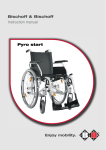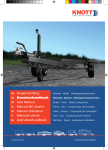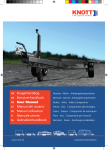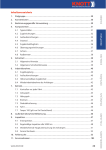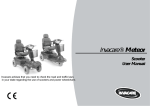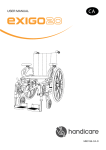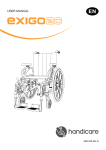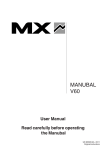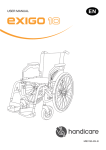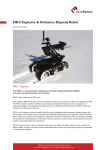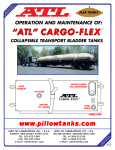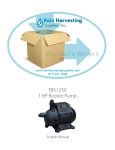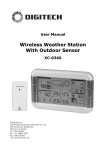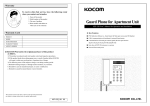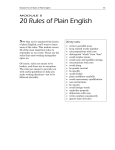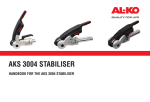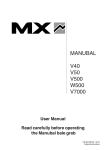Download danskengl is hespa с olfran з a is it al ia nonederlandsdeutsch
Transcript
2. Warning and general notices .................................................................................... 56 3. Intended application ................................................................................................... 56 4. Components ................................................................................................................. 57 Coupling devices ................................................................................................... 58 4.3 Overrun couplings ................................................................................................. 59 4.4 Jockey wheel ......................................................................................................... 61 4.5 Drawbar/Towbar.................................................................................................... 62 4.6 Transmission devices .............................................................................................. 63 4.7 Axles ..................................................................................................................... 63 4.8 Wheel brakes ........................................................................................................ 64 Safety............................................................................................................................ 65 5.1 General remarks .................................................................................................... 65 5.2 General safety remarks .......................................................................................... 65 6.1 Ball coupling ......................................................................................................... 66 6.2 Overrun couplings ................................................................................................ 66 6.3 Height adjustable drawbar .................................................................................... 67 6.4 Recommissioning the trailer .................................................................................. 68 Operation ..................................................................................................................... 69 7.1 Checks before every use ........................................................................................ 69 7.2 Hitching up .......................................................................................................... 69 7.3 Unhitching ............................................................................................................ 70 7.4 Brakes ................................................................................................................... 71 7.5 Theft protection .................................................................................................... 72 7.6 Travel .................................................................................................................... 72 7.7 Speed limit 100 (applies only to Germany) ............................................................. 72 8. Decommissioning/Withdrawal from service .............................................................. 72 9. Inspection ..................................................................................................................... 73 9.1 Initial inspection ................................................................................................... 73 9.2 Regular inspection every 5000 km ....................................................................... 74 9.3 Recurring general inspection of the trailer ............................................................. 77 9.4 Proof of servicing .................................................................................................. 78 10. Troubleshooting .......................................................................................................... 79 11. Servicing addresses ...................................................................................................... 185 www.knott.de 55 ESPAÑOL Commissioning............................................................................................................. 66 FRANÇAIS 7. 4.2 ITALIANO 6. Rating plates ......................................................................................................... 57 NEDERLANDS 5. 4.1 DEUTSCH Target group ................................................................................................................ 56 ENGLISH 1. DANSK Contents Brakes Axles User Manual 1. Target group This User Manual is intended for the end users of ready assembled trailers with integrated KNOTT trailer components. 2. Warning and general notices A DANGER Draws your attention to a hazardous situation which will result in serious injury or death if not prevented. WARNING Draws your attention to a hazardous situation which can result in serious injury or death if not prevented. CAUTION Draws your attention to a hazardous situation which can result in minor to moderately severe injury if not prevented. F NOTICE Draws your attention to possible material damage or other important information in connection with the machine. 3. Intended application KNOTT trailer components are assembled by a vehicle manufacturer to produce a complete trailer by the addition of attachments which do not form part of the scope of supply. KNOTT trailer components can be used for single or multiple-axle category O1/ O2 trailers. The complete trailer requires a General Operating Permit and a certificate of suitability for use on public roads, and must be in compliance with applicable national regulations. Liability disclaimer Any other or further-reaching use than that outlined under the “Intended application” above is deemed not in accordance with the prescribed purpose of the equipment. The manufacturer may not be held liable for resulting damages. The registered trailer may be coupled to vehicles with the relevant towing approval. A DANGER Danger of accidents due to impaired travel stability of the trailer! Ź Do not travel with a negative vertical load. Ź Adhere to the admissible static vertical load and admissible total weight of all involved components. Ź Utilize the vertical load within the admissible limits. Ź Do not exceed the admissible static vertical load of the towing vehicle. Ź Notes on loading, see 5.2, page 65. Regular renewal of the General Operating Permit The trailer is required to pass an official inspection (general inspection) held at regular intervals. For more details, please refer to the applicable national regulations, see als 9.3, page 73. 56 Brakes Axles User Manual | © Knott GmbH | 01 - 2012 Components KNOTT chassis comprise the coupling device (ball coupling/towing eyelet), the overrun coupling, the drawbar/towbar, the transmission device, the axles and the wheel brakes. DEUTSCH KNOTT chassis can be supplemented with a wide range of accessories. 5 5 4 4 6 1 1 2 3 4 5 6 Coupling device (ball coupling, towing eyelet) Overrun coupling Drawbar/towbar Transmission device (linkage, brake compensation balance, bowden cables) Axles Wheel brakes Rating plates ESPAÑOL 4.1 6 3 ENGLISH 2 DANSK 4. All information contained on the rating plate or optionally on the component is embossed or needle printed. 1 Overrun coupling with coupling device FRANÇAIS 3 1 2 2 Towbar (right-hand towbar) 4 Towing eyelet www.knott.de 57 NEDERLANDS 3 Ball coupling (information on handle or housing) ITALIANO 4 Brakes Axles User Manual 5 Wheel brake 6 Axle 5 6 4.2 Coupling devices 4.2.1 Ball coupling Functional characteristics The ball coupling connects the trailer to the towing vehicle. Models Series K Series AV 2 4 3 3 5 1 1 6 1 2 3 Locking and wear display Handle Unlocking the handle 4 5 6 Protective cover Lock (theft protector) Spherical cap (ball hitch) Admissible pivot ranges Pivot range around the vehicle‘s longitudinal axis (roll axis) 58 max. ±25° Pivot range in the horizontal direction (pitch axis) max. ±20° Pivot range around the vertical axis max. ± 90° Brakes Axles User Manual | © Knott GmbH | 01 - 2012 2 DANSK F NOTICE Danger of overloading components and malfunctions! t The admissible pivot ranges must not be exceeded. t The admissible static vertical load and the admissible overall weight must not be exceeded. DEUTSCH Theft protector The theft protector effectively prevents the ball coupling being opened or unauthorized coupling and uncoupling of the trailer. CAUTION Danger of crushing fingers due to the spring-loaded closing mechanism of the spherical cap! Ź Never reach your fingers into the spherical cap of the ball coupling from below. 4.2.2 Towing eyelet ENGLISH Functional characteristics The towing eyelet connects the trailer to the towing vehicle. DIN towing eyelet French towing eyelet ESPAÑOL Models NATO towing eyelet 4.3 FRANÇAIS F NOTICE Danger of overloading components and malfunctions! t The admissible static vertical load and the admissible overall weight must not be exceeded. Overrun couplings Functional characteristics 5 2 3 4 5 Braking the towing vehicle causes a decelaration force to be exerted on the drawbar. This force pushes in the drawbar 1 of the overrun coupling. This necessitates overcoming a response threshold in the shock absorber. During this process, the transmission lever is actuated by the drawbar. The wheel brakes 5 are actuated via the transmission linkage 2 , the brake compensation balance 3 and the bowden cables 4 . www.knott.de 59 NEDERLANDS 1 ITALIANO 4 Brakes Axles User Manual Overrun coupling components 1 2 3 3 10 5 8 4 1 5 6 10 7 6 4 7 8 9 10 9 2 Handbrake lever Breakaway cable Housing Linkage Shock absorber (internal) Transmission lever Coupling device (ball coupling or towing eyelet) Damped spring accumulator Support leg Guide bearing with greasing nipple Handbrake (parking brake) The handbrake permits a secure hold when parked. Models with automatic reverse With the handbrake lever actuated, the braking force is maintained by the spring accumulator. The spring forces tension the brake shoe via the brake linkage and the bowden cables and so prevent them from being released. This prevents the wheel brakes from being released if the automatic reverse should release slightly. Breakaway cable and support leg The breakaway cable activates the parking brake in the event that the trailer becomes unintentionally detached from the towing vehicle. The support leg prevents the handbrake lever from touching the ground in the event that the trailer is unintentionally lost. This prevents accidental release of the brake. Series and typical applications Series Application KF and KFG Mounting on towbars (V drawbar) t KF in sheet metal version up to 3000 kg t KFG as cast version up to 3500 kg KR/KV Tubular version up to 3500 kg KRV Mounting on a tubular drawbar (as part of the vehicle frame) KFGL (previously: KFZ) Application in fifth-wheel trailers on the forked drawbar „KLZ“ Versions of the handbrake lever Abbreviation 60 Property For series GF (GFH, GFV) Handbrake with damped spring accumulator All HF Handbrake with toothed segment and spring accumulator KF, KFG KH Handbrake with spring accumulator All Brakes Axles User Manual | © Knott GmbH | 01 - 2012 F NOTICE Danger of material damage! Do not manhandle the trailer over long distances or drive over any obstacles (such as kerbstones). Simple jockey wheels are fastened by means of a clamp to the drawbar. The clamp can also be used to fix the height of the jockey wheel. Automatic jockey wheels are hinged downwards when the trailer is hitched to the towing vehicle to allow the jockey wheel to be subsequently cranked downwards and the trailer lifted off the coupling ball. As a safeguard to prevent jockey wheels from working loose, the lower end of the outer pipe is fitted either with a chamfer or two notches into which the inner pipe engages, preventing it from turning. DANSK Jockey wheel Functional characteristics The jockey wheel is used for supporting and manhandling the trailer after disconnection from the towing vehicle. DEUTSCH 4.4 ATK ENGLISH Models TK Release bolts (from this position, do not lower the jockey wheel any further) ESPAÑOL Clamp for height adjustment and fixture of the jockey wheel FRANÇAIS Automatic jockey wheel (rough adjustment using the flap mechanism and spindle drive) WARNING Danger of injury caused by dropping drawbar! If the automatic jockey wheel is lowered too far, the flap mechanism can be triggered, causing the drawbar to drop. ITALIANO 8 Ź Only crank up the jockey wheel when coupled to the towing vehicle! 9 8 8 www.knott.de 61 NEDERLANDS Standard jockey wheel (adjustment by means of clamp and spindle drive) Brakes Axles User Manual 4.5 Drawbar/Towbar Functional characteristics The drawbar is a power-transmitting component which links the overrun coupling to the frame of the trailer. If a height-adjustable drawbar is used, the coupling height of the trailer can be adjusted to that of the towing vehicle. WARNING Danger of accidents! No structural changes may be carried out at drawbars/towbars. Drilling work or welding of any kind is prohibited. Models V drawbar (towbar) Height-adjustable drawbar Height-adjustable drawbars Model KHV/KHA: The angle between the drawbar and the adapter can be adjusted from -10° to +49°. The face splines are connected by means of a threaded bolt and a lock nut. A lifting and adjusting device can be optionally integrated between the drawbar and the overrun coupling. An integrated gas spring generates an independent lifting force which substantially reduces the degree of force needed for actuation. Model KHD: The angle between the drawbar and the adapter can be adjusted from -10° to +60°. The adjustable articulated connection between the drawbar and adapter and between the overrun coupling and adapter is formed using a bolt bearing. The position is fixed by a diagonally positioned strut or spindle. The bolt at the spindle which drives the worm must be secured against working loose using a spring clip or splint. The spring clip or splint is connected to the drawing tube by a chain. 62 Brakes Axles User Manual | © Knott GmbH | 01 - 2012 Standard model Optional model 3 3 3 2 3 2 2 2 1 2 4 Linkage Compensation balances (3x) 3 4 Bowden cables to the wheel brake Turnbuckle Axles 1 ESPAÑOL 4.7 2 ENGLISH 1 1 DEUTSCH When using a height-adjustable drawbar, the actuating path from the overrun coupling is transmitted to the wheel brakes via a bowden cable and linkage. DANSK Transmission devices Functional characteristics The linkage and bowden cables transmit the tensile forces for braking from the overrun coupling to the wheel brake. The brake compensation balances are required to compensate for different clearances in the wheel brakes and to ensure that the same forces are transmitted to all wheel brakes. 2 1 2 3 Axle tube Support trestle / flange plate Brake stub axle with wheel connection 3 Functional characteristics The axle transmits the suspended weight of the trailer to the wheels, absorbing all occurring forces. FRANÇAIS 4.6 Admissible axle load up to max. 750 kg Braked axles Admissible axle load up to max. 3500 kg Series Description VG / VGB Rubber spring axle GB Translational torsional suspension axle DB Torsion bar spring axle www.knott.de 63 NEDERLANDS Unbraked axles ITALIANO Models Brakes Axles User Manual 4.8 Wheel brakes 3 2 1 1 4 2 3 4 Simplex brake shoe with lining Backmat brake shoe with lining (with automatic reverse) Expanding lock Brake drum Functional characteristics Mechanical wheel brake The expanding lock of the mechanical wheel brake is actuated via the transmission device. This causes the brake shoes to be pressed from the inside against the drum. The trailer is braked. Hydraulic wheel brake The wheel brake cylinder of the hydraulic wheel brake is actuated using the hydraulic system. This causes the brake shoes to be pressed from the inside against the drum. The trailer is braked. In the hydraulic wheel brake, actuation of the parking brake takes place mechanically by means of the bowden cable. Automatic reverse (Backmat) The automatic reverse permits reverse travel without manually applying a block. During reverse travel, a certain residual braking moment has to be overcome. Automatic adjustment for brakes with automatic reverse Automatic adjustment compensates for lining wear and so ensures an optimized effect in the long term. Well adjusted brakes enhance ride comfort and also reduce braking distances. 64 Brakes Axles User Manual | © Knott GmbH | 01 - 2012 Safety 5.1 General remarks DANSK 5. The brake system, the overrun coupling and transmission device, as well as the wheel brakes and the coupling device must be tested in accordance with the relevant EC/ECE directives. A DANGER Danger of injury in case of failure to observe the following remarks! Ź Adjust your speed to the current driving and road conditions. Ź Adjust your driving speed in accordance with the condition of the road surface and the cargo or loading condition of the trailer, especially when cornering. Ź When parking the trailer, ensure that you have left sufficient clearance. Until the full braking force is applied, the trailer can roll back by 20 to 30 cm. Ź When parking the trailer, secure against rolling using chocks. In trailers with overrun brakes: Apply the trailer’s handbrake. For secure loading of the trailer, the following remarks must be observed: Ź Observe the instructions of the trailer manufacturer. Ź Never overload the trailer (avoid overloading the trailer components). Ź Ensure that the trailer is correctly loaded (avoid extreme shifts in the centre of balance caused by incorrect loading). Ź Stow heavy objects close to the axles as low down as possible. Ź Secure the load against falling or being slung out of the trailer. www.knott.de 65 NEDERLANDS ITALIANO FRANÇAIS To ensure personal safety and prevention of injury, observe the following remarks: Ź Trailers may not be used to transport people. Ź During manhandling operations, when hitching and unhitching, never step between the trailer and a fixed standing obstacle. ENGLISH General safety remarks ESPAÑOL 5.2 DEUTSCH KNOTT ensures that the trailer components are correctly coordinated. They may only be used in the approved combination. Brakes Axles User Manual 6. Commissioning WARNING Danger of accidents due to faulty or unprofessional work performed at the trailer! Repairs, setting and conversion work may only be performed by an authorized professional workshop in accordance with the KNOTT maintenance manual. 6.1 Ball coupling Checking the position of the ball coupling The coupling heights of the towing vehicle and the trailer must coincide: 1. Set the tyre pressure of the trailer to the pressure recommended by the tyre manufacturer. 2. Load the trailer to its maximum admissible overall weight. 3. Hitch up the trailer, see Hitching up, page 69 9 8 8 On a level surface without any incline, the coupling heights of the towing vehicle and the trailer must coincide to ensure the optimum driving and braking performance of the trailer. Lock (theft protector) Note the key number (for ordering spares if required). 6.2 Overrun couplings Design of the handbrake lever KH A DANGER Danger of injury due to sudden actuation of the brake lever as a result of a pretensioned spring! Ź The handbrake lever model “KH” is under tension in the released position. Do not remove the red lock screw M10 until the overrun coupling and brake linkage are mounted in the trailer and the complete brake system is adjusted. Before removing the overrun coupling and carrying out any maintenance or repair work or dismantling the brake system, always screw the lock screw back in without fail. 66 Brakes Axles User Manual | © Knott GmbH | 01 - 2012 DANSK Requirement t The overrun coupling and brake linkage are mounted in the trailer. t The complete brake system is correctly adjusted. Commissioning the overrun coupling Remove the red lock screw M10 and keep in a safe place. Height adjustable drawbar WARNING Danger of accidents! The overrun coupling / coupling device must always be aligned parallel to the drawbar. It is not admissible to drive if the drawbar is not parallel to the overrun coupling. Setting the height of the drawbar The clamp nut must be tightened to a prescribed tightening torque in order to ensure a backlash-free torque-transmitting connection: 200 Nm with M16 bolt 350 Nm with M20 bolt 550 Nm with M28 bolt 850 Nm with M36 bolt ENGLISH t t t t DEUTSCH 6.3 1 2 Clamp nuts Spring clips 1. Pull off the spring clips at the clamp nuts. F NOTICE Secure the front section against falling out. 2. Unscrew the clamp nuts of the adapters until the teeth are free. 3. Adjust the angular position of the adapter in such a way that the coupling height is reached. 4. To clamp together, tighten the clamp nuts at the face spline. 5. Plug in the spring clips at the clamping nuts in order to secure the nuts against working loose. www.knott.de 67 ITALIANO 1 NEDERLANDS 2 FRANÇAIS ESPAÑOL Model KHV/KHA Brakes Axles User Manual Model KHD 1. Pull off the spring clip at the adjusting crank 2. Set the drawbar to the right height using the crank 3. Secure the adjusting crank again with the spring clip. F NOTICE Danger of overloading Only actuate the adjusting mechanism when the trailer is uncoupled from the towing vehicle. F NOTICE Do NOT use the height adjusting mechanism to tilt the loading surface! 6.4 Recommissioning the trailer Checks after a long period out of use t Check the general condition t Check the tyre tread t Check the air pressure t Check that the lighting system is in good working order Ball coupling Grease all moving parts of the ball coupling - apart from the spherical cap - with standard commercially available machine grease. 68 Brakes Axles User Manual | © Knott GmbH | 01 - 2012 Checks before every use Before every trip, inspect: t Tyres: Check the tyre tread and air pressure t Lighting system: Check for correct function t Raise the jockey wheel as far as possible and lock. Secure against being lost or working loose. If applicable secure the crank with the spring clip against working loose. The jockey wheel should always be positioned parallel to the direction of travel. t Lock the ball coupling securely into place t Suspend the breakaway cable t Release the parking brake t Height adjustable coupling device: Check joints for a firm fit, ensure that bolts are securely locked NOTE When using a detachable towing fixture on the vehicle, suspend the breakaway cable on the rigid section of the towing fixture. Clip into the eyelet or loop around the bracket and clip in the cable. Ensure that sufficient cable length is left to allow for cornering. 6. Insert the electric plug into the socket of the towing vehicle. 7. For trailers with jockey wheel: Completely raise the jockey wheel, tighten the clamp. The breakaway cable must not wind around the jockey wheel. With automatic jockey wheels: Completely crank up the jockey wheel. While doing so, insert the inner pipe into the twist lock of the outer pipe and tighten. The jockey wheel should always be positioned parallel to the direction of travel. WARNING Danger of accidents due to unwanted floor contact of the jockey wheel if not completely raised and secured during travel. Before setting off, always ensure that the jockey wheel is secured against being lost or working loose. To do this, crank the jockey wheel completely up and tighten the clamping device. 8. Remove any chocks from under the wheels. 9. In the case of trailers with overrun brake: Release the trailer handbrake. www.knott.de 69 ESPAÑOL FRANÇAIS F ITALIANO 1. Open the coupling and place on the coupling ball of the towing vehicle. 2. For trailers with automatic jockey wheel: Crank up the jockey wheel. Place the ball coupling over the coupling ball of the towing vehicle. Crank down the jockey wheel until the ball coupling audibly clicks into place. 3. Check the position of the safety display: The pointer must be in the green zone with “+”. WARNING If the pointer is in the red zone with “-”, then the coupling has not closed correctly and the trailer must not be driven. The coupling is lying loosely on the ball and could jump apart when pulling away. To ascertain the cause, see Troubleshooting, page 79. 4. Test for a correctly engaged ball coupling with a tension test (lifting the coupling). 5. For trailers with overrun brakes: Suspend the breakaway cable at the ball neck or on an eyelet on the towing vehicle. WARNING Danger of injury if the trailer breaks away from the towing vehicle for any reason. Suspend the breakaway cable before every journey. ENGLISH Hitching up NEDERLANDS 7.2 DANSK Operation 7.1 DEUTSCH 7. Brakes Axles User Manual A DANGER Danger of injury and material damage due to incorrectly coupled trailer! Ź After hitching up, always check at the safety display that the coupling is seated correctly on the coupling ball. Ź If the coupling is not correctly closed, the trailer must not be driven. Safety display Marking Coupling position Handle position Meaning X Coupling is open Handle is pulled up WARNING The vehicle/ trailer combination must NOT be driven. + Coupling is closed Handle is in starting position The vehicle/trailer combination may be driven. - Faulty condition Handle is in starting position WARNING The vehicle/ trailer combination must NOT be driven. For causes, see Troubleshooting, page79. F NOTICE The safety display is additionally embossed under the label. If the label is damaged, the safety display can still be read. If the label is replaced, the separating lines on the label and embossing must coincide. 7.3 Unhitching 1. WARNING Danger of injury caused by uncontrolled rolling of the trailer! Secure the trailer against rolling away using chocks. 2. In trailers with overrun brakes: Tighten the handbrake. 3. Unlock the coupling handle and pull it upwards. 4. In trailers with jockey wheel: Crank down the jockey wheel with the coupling handle in the raised position. WARNING Danger of injury due to tilting trailer! Unhitch trailers with jockey wheel only when the jockey wheel is cranked down. 5. Disconnect the electric plug from the socket of the towing vehicle and insert in the retainer. 6. In trailers with overrun brakes: Release the breakaway cable from the towing vehicle and wind around the coupling. 7. Unhitch the trailer: Lift the ball coupling off the towing fixture. In trailers with jockey wheel: Crank down the jockey wheel until the ball coupling is located over the towing fixture. 70 Brakes Axles User Manual | © Knott GmbH | 01 - 2012 Brakes DANSK 7.4 Service brake When using braked trailers, when the towing vehicle brakes the trailer is automatically braked at the same time by the overrun coupling. Handbrake (parking brake) Model GF Brake released 1 1 2 3 4 DEUTSCH Brake applied Handbrake lever l Damped spring accumulator Transmission device (brake linkage) Breakaway cable Model HF Pull the handbrake lever until the last ratchet. This is necessary to ensure sufficient travel reserve in the spring accumulator to bridge the automatic reverse. WARNING Danger of injury! If the automatic reverse releases slightly, the spring accumulator automatically tensions the handbrake lever. Ź Never reach into the pivot range. Releasing the handbrake WARNING Danger of injury caused by uncontrolled rolling of the trailer! Ź Before the handbrake is released, secure the trailer against rolling away using chocks. ITALIANO Model GF, GFH, GFV and KH Push the handbrake lever down. Model HF Press down the release button at the handbrake lever and press the handbrake lever downwards. www.knott.de ESPAÑOL Applying the handbrake Model GF, GFH, GFV and KH Pull the handbrake lever over the dead centre. The spring accumulator ensures sufficient tensile stress of the wheel brakes. FRANÇAIS 4 71 NEDERLANDS 3 ENGLISH 2 Brakes Axles User Manual 7.5 Theft protection Requirement: The ball coupling must be closed. To do this: t Hitch the ball coupling to the towing vehicle orr t when unhitched, insert coupling ball KSB 50 (or ball with Ø 50 mm). Locking the ball coupling 1. Insert the key in the lock. 2. Push the key with lock downwards and turn counter clockwise by 90°. 3. Pull out the key. Open the ball coupling 1. Insert the key in the lock. 2. Turn the key with lock by 90° in the clockwise direction and allow the lock to click into place at the top. 7.6 Travel 7.6.1 Basic rules for safe towing operation. t Adjust your driving speed in accordance with the condition of the road surface and the cargo or loading condition of the trailer, especially when cornering. t Drive as smoothly as possible. t Never overload the trailer (avoid overloading the trailer components). t Ensure that the trailer is correctly loaded (avoid extreme shifts in the centre of balance caused by incorrect loading). t Stow heavy objects close to the axles as low down as possible. t Avoid stress due to impacts or bumps. t Utilize but at the same time do not exceed the maximum admissible static vertical load of all involved components. 7.7 Speed limit 100 (applies only to Germany) Under certain conditions, a trailer can be approved for speeds of 100 km/h. In this case, a sign is issued which must be applied on the back of the trailer. 8. Decommissioning/Withdrawal from service Decommissioning or temporarily withdrawing the trailer from service: 1. Secure the trailer against rolling away using chocks. 2. Release the handbrake. 72 Brakes Axles User Manual | © Knott GmbH | 01 - 2012 Inspection To maintain operating and traffic safety, the trailer must be inspected at the following intervals. If used only rarely, the inspections must be carried out at least once a year. DEUTSCH WARNING Danger of accidents due to faulty or unprofessional work performed at the trailer! Repairs, setting and conversion work may only be performed by a specialist workshop in accordance with the KNOTT maintenance manual. DANSK 9. Only KNOTT original parts may be used to ensure that t functional characteristics and safety are guaranteed. t warranty and guarantee claims do not lose their validity. t the operating permit remains valid in accordance with national and international regulations. 9.1 9.1.1 ESPAÑOL ENGLISH F NOTICE Jacks may only be positioned under support trestles or at the vehicle frame. Initial inspection Wheel nuts After the first 50 km or 50 km after a wheel change, the wheel nuts must be checked using a torque spanner to ensure that they comply with the prescribed tensioning torque. FRANÇAIS The tightening torque specifications of the rim manufacturer are applicable. Size across flats Tightening torque M12x1,5 19 (17) 80-90 Nm M14x1,5 19 110-120 Nm Wheel change Tighten wheel nuts diagonally A DANGER Danger of accidents! Wheel nuts can work loose. Ź Only use wheel nuts which are approved by the rim manufacturer. www.knott.de 73 NEDERLANDS Wheel nut ITALIANO In the absence of any other specifications, this recommendation is applicable: Brakes Axles User Manual 9.2 Regular inspection every 5000 km 9.2.1 Ball coupling Check for signs of wear on the coupling ball and ball coupling 1. Hitch the trailer to the towing vehicle. 2. Read the wear condition at the safety display Marking + - Wear condition Wear condition OK Coupling ball or ball coupling are worn Lubricating moving components 1. Unhitch the trailer from the towing vehicle 2. Lubricate all moving parts of the ball coupling - apart from the spherical cap - with standard customary machine grease. When using a stabilization coupling: Do not lubricate either the ball or the spherical cap Check the diameter of the coupling ball at the towing vehicle Exchange the towing fixture if 1. the diameter of the coupling ball is less than 49.5 mm or 2. the coupling ball is out of round. 9.2.2 Overrun coupling Lubrication 1. Relubricate the overrun coupling at both lubricating nipples. 2. Lightly oil all moving parts such as bolts and articulated points of the handbrake lever and the reversing lever. Readjusting 1. Apply the handbrake. 2. Push the drawbar in over the ball coupling. If the drawbar can be pushed in by more than 45 to 50 mm, have the brake system readjusted by an approved professional workshop. Checking the function of the overrun damper 1. Unhitch the trailer. 2. Apply the handbrake. 3. Push back the trailer until the handbrake lever is in the end position. 4. Then push the drawbar into the overrun coupling over the ball coupling. The drawbar must return automatically to the zero position. If the return travel takes longer than around 30 seconds, the overrun coupling must be checked in an approved professional workshop. Checking the spring accumulator at the handbrake lever 1. Carry out a visual inspection for damage (KH and GF) and leaks at the oil damper (GF). 2. Check the handbrake lever for easy running. 74 Brakes Axles User Manual | © Knott GmbH | 01 - 2012 Check condition 1. Check for cracks and signs of damage. Exchange damaged / deformed side bars and towbars. Do not attempt to straighten out and reuse. 2. Tighten all screw joints. ENGLISH Observe specified tightening torques: t 45 Nm with screw M 10 (8.8) t 77 Nm with screw M 12 (8.8) t 115 Nm with screw M 12 (10.9) t 125 Nm with screw M 14 (8.8) t 180 Nm with screw M 14 (10.9) t 190 Nm with screw M 16 (8.8) t 280 Nm with screw M 16 (10.9) ESPAÑOL Height adjustable drawbar Clean the height adjusting device and lubricate 1. Pull the spring clips out of the clamp nuts. 2. Unscrew the clamp nuts at the face spline until the teeth are free. 3. Clean the tooth system of dirt and fretting rust using a steel brush. 4. Lubricate threaded bolts and articulated joints. F NOTICE Do not lubricate the tooth system. 5. Tighten the clamp nuts and insert the spring clips. Observe tightening torque levels: see 6.3, Height adjustable drawbar, page 67. 9.2.5 Transmission device 1. Check that bowden cables and linkage are running easily. 2. Have any stiff running bowden cables replaced by an approved professional workshop. 9.2.6 DEUTSCH Drawbars, side bars and cross bars FRANÇAIS 9.2.4 DANSK Jockey wheel and cable winch Checking the condition and correct working order 1. Check that the jockey wheel is in correct working order: Check that the crank runs easily and lubricate if necessary. 2. Check that the winch is in correct working order: Check the cable / tape for damage. Exchange if necessary. Axles Series Description Maintenance VG / VGB Rubber spring axle Maintenance free GB Translational torsional suspension axle DB Torsion bar spring axle www.knott.de ITALIANO Lubrication Grease at all lubricating nipples. 75 NEDERLANDS 9.2.3 Brakes Axles User Manual Bearing bushes 9.2.7 Wheel brake Checking the thickness of the brake lining Brake linings are wearing parts and must be checked at every inspection. Viewing hole At every brake 1. Remove the dust cap from the viewing hole on the back of the wheel brake. 2. Check the thickness of the brake lining through the viewing hole: With a minimum lining thickness of 1 mm, have the brake shoe replaced by an approved professional workshop. F NOTICE Even if one lining is just 1 mm below specified thickness, all brake linings of an axle must be exchanged. In this case, we recommend changing all brake shoes on all axles. 3. Replace the dust caps. Readjusting the wheel brake Not required in the case of wheel brakes with automatic adjuster. These are identified by the words “auto adjust” on the dust caps. Have wheel brakes adjusted by an approved professional workshop. WARNING Danger of accidents! After a brake shoe change, it takes a while for the full braking effect to be reached. Ź For the first 100 km, drive with particular care. 76 Brakes Axles User Manual | © Knott GmbH | 01 - 2012 DANSK Wheel bearings Checking lateral bearing play 1. Jack up the trailer. 2. Check lateral bearing play. If there is noticeable play, have the trailer checked by an approved professional workshop. 9.2.9 Wheels and tyres 1. Check for signs of ageing, such as cracks and other damage. 2. Test tyre pressure and minimum tread depth in accordance with statutory regulations. 3. Exchange damaged tyres and tyres with a tread below the required minimum. WARNING Danger of accidents! Ź Following a wheel change, tighten the wheel nuts after around 50 km. DEUTSCH 9.2.8 Check for damage 1. Check plug and cable for damage 2. Check the cable fastenings. Cables must not hang down. 3. Check the lighting system housing/lens for damage. 4. Have damaged plugs, cables and lamp housings replaced by an approved professional workshop. If the lighting system does not work even though the lamps are in order and following a visual inspection, have the electrical system checked by an approved professional workshop. Recurring general inspection of the trailer In accordance with EC law, every vehicle must be cyclically checked for road traffic safety. Observe the legal road safety regulations applicable in your country. www.knott.de 77 NEDERLANDS ITALIANO In accordance ith the legal requirements, the trailer must be presented for a general inspection to an approved test centre. FRANÇAIS 9.3 ESPAÑOL Function testing 1. Connect the plug of the trailer to the socket on the towing vehicle. 2. Check the lighting system functions and replace any defective bulbs. ENGLISH 9.2.10 Electrical system Brakes Axles User Manual 9.4 78 Proof of servicing Initial inspection Inspection every 5000 km or yearly Date: Date: Stamp: Stamp: Inspection every 5000 km or yearly Inspection every 5000 km or yearly Date: Date: Stamp: Stamp: Inspection every 5000 km or yearly Inspection every 5000 km or yearly Date: Date: Stamp: Stamp: Brakes Axles User Manual | © Knott GmbH | 01 - 2012 Fault Cause Remedy Insufficient braking effect Excessive backlash in the brake system Only by an approved professional workshop Brake linings not run in Carry out around 10 repeated braking processes from medium speed (50 - 60 km/h) Brake lining glazed over, oily or damaged Only by an approved professional workshop Overrun coupling is stiff running Lubricate overrun coupling see 9.2.2, page 74 DANSK Troubleshooting Faults and their remedy DEUTSCH 10. Brake linkage jamming or bent Brake bowden cable corroded or bent ENGLISH Excessive backlash in the brake system Overrun coupling shock absorber defective Backmat brake shoes jamming in the brake shoe holder Trailer brakes unevenly on one side Wheel brakes are working on one side only Trailer brakes as soon as the accelerator is released Overrun coupling shock absorber defective Reverse travel is heavy going or not possible Brake system adjusted too tightly Only by an approved professional workshop ESPAÑOL Jerky braking action Bowden cables pre-tensioned Incorrect setting Wheel brakes running hot Tighten handbrake lever as far as possible Incorrect brake system setting Wheel brakes soiled Reversing lever of the overrun coupling is jamming Only by an approved professional workshop Spring accumulator is already pretensioned in zero position Ball coupling does not lock into place after lowering on the ball www.knott.de Handbrake lever was released only partially or not at all Set the handbrake lever to the zero position Internal components soiled Clean the ball coupling and lubricate, see 9.2.1, page 74 Ball on the towing vehicle does not fit Check the diameter of the ball on the towing vehicle, see 9.2.1, page 74 79 ITALIANO Handbrake lever not tightened firmly enough NEDERLANDS Insufficient handbrake action FRANÇAIS Backmat brake shoes jamming in the brake shoe holder

























